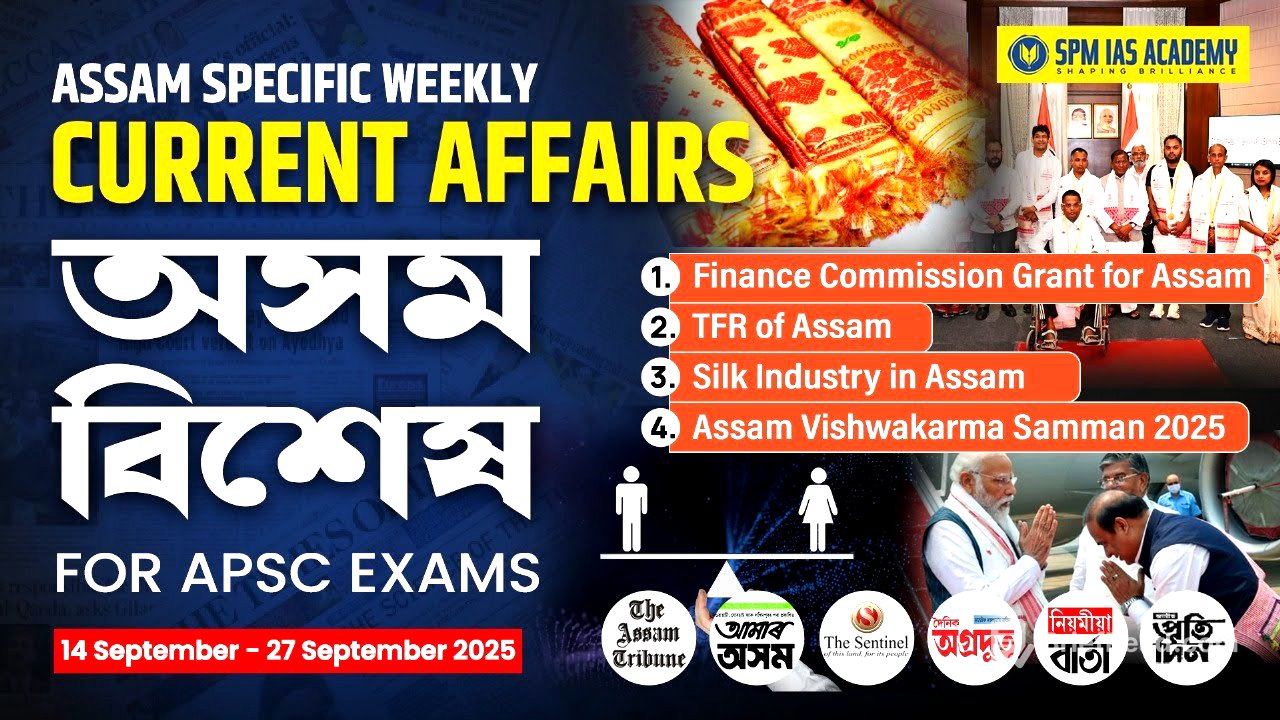TLDR;
This video provides a comprehensive overview of recent current affairs in Assam, focusing on finance, demographics, industry, and notable achievements. It covers topics such as the Finance Commission grant for Assam, the state's Total Fertility Rate (TFR), the silk industry, the Assam Vishwakarma Samman 2025 awards, a world record in Takori-Ghura, the scaling of Mt. Leo Pargil, the discovery of a new freshwater fish species, and the establishment of a Neem Corridor.
- Finance Commission grant released for Assam's rural local bodies.
- Assam's TFR is decreasing, indicating positive trends in population management.
- The silk industry in Assam faces challenges but holds significant economic and cultural value.
- Assam Vishwakarma Samman 2025 recognizes individuals with disabilities for their outstanding contributions.
- Recent achievements include a world record in Takori-Ghura, the scaling of Mt. Leo Pargil, and the discovery of a new freshwater fish species.
- The establishment of a Neem Corridor highlights environmental initiatives in the state.
Introduction [0:00]
The speaker introduces the scope of the video, which will cover important current affairs from the last two weeks, focusing on topics relevant to Assam. The speaker emphasizes that the discussion will avoid controversial topics and instead focus on factual information and significant contributions to the nation.
Topics of the day [1:46]
The speaker outlines the topics to be covered in the video, including the Finance Commission grant for Assam, the Total Fertility Rate (TFR) of Assam, the silk industry in Assam, the Assam Vishwakarma Samman 2025, the Takori-Ghura World Record, Mt. Leo Pargil scaling, a new freshwater fish discovery, and the Neem Corridor project.
Finance Commission Grant for Assam [2:26]
The central government has released over ₹342 crore as a 15th Finance Commission grant for Assam, specifically for rural local bodies. This grant aims to improve drinking water and sewage cleanliness in rural areas. The grant is untied, meaning it can be used across 29 subjects listed in the 11th schedule of the Indian Constitution, including animal husbandry, minor irrigation, land improvement, agriculture, and fisheries. The 15th Finance Commission, chaired by NK Singh, submitted its final report in February 2021, outlining vertical devolution (division of funds between the center and states) and horizontal devolution (distribution among states based on criteria like income distance, area, population, forest and ecology, tax effort, and demographic performance). Assam, along with Tamil Nadu, benefits from this grant, with ₹14 crore allocated to Assam. The Ministry of Panchayat Raj, Ministry of Jal Shakti, Department of Drinking Water and Sanitation, and the Ministry of Finance are involved in the disbursement and utilization of these funds.
TFR of Assam [9:04]
The Total Fertility Rate (TFR) in Assam is decreasing, which is a positive trend. TFR refers to the average number of children a woman is expected to have in her lifetime, based on current age-specific fertility rates. In Assam, the TFR has decreased from 2.2 in 2018 to 2.0 in 2023. The ideal TFR is considered to be 2.1. Rural TFR in Assam is 2.1, while urban TFR, particularly in areas like Guwahati, is 1.6. Education plays a significant role in TFR, with illiterate women having a TFR of 2.7, while women with higher education levels have a TFR as low as 1.6. The Gross Reproduction Rate (GRR) in Assam is 0.9, and the Crude Birth Rate (CBR) is 18.4, compared to the national average of 19.7. Assam maintains a good sex ratio, especially in urban areas, due to increased education and reduced female foeticide. Institutional deliveries in Assam are at 85%, with 73% occurring in government hospitals and 25% in private hospitals. Compared to other states, Bihar has a higher TFR of 2.8, while Delhi has the lowest. Access to education, healthcare, and family planning contributes to TFR control in urban areas.
Silk Industry in Assam [16:18]
Assam is famous for its Muga, Eri, and Pat silk varieties. The silk industry is culturally and economically significant, with approximately 280,000 farmers involved in sericulture, including 35,000 in Muga silk production. Muga silk faces shortages due to extreme summer conditions affecting the host plant, which is essential for silk worm rearing. The demand for silk is high, but production is low, leading to a demand-supply mismatch. Mahadanand Chutia, a scientist from the Central Silk Board, highlights the need to increase production to meet the demand. The silk industry is emerging as a major rural livelihood source, with potential for commercialization and innovation. Government schemes like the Silk Samagra Scheme support the industry through funding and infrastructure development. A new Muga mill has been inaugurated in Bishwanath, with a 7-metric ton annual capacity. The Northeast Region Textile Promotion Scheme also supports the silk industry. Challenges include climate change, unpredictable weather, rising temperatures, rainfall shortages, pests, diseases, competition from synthetic fibers, and youth migration to other sectors. Despite these challenges, Assam has a competitive advantage in the luxury market due to the sentimental and emotional value associated with its silk.
Assam Vishwakarma Samman 2025 [25:15]
The Assam Vishwakarma Samman 2025 recognizes individuals with disabilities for their outstanding courage, innovation, and dedication. The awards were presented by the Governor of Assam, Shri Laxman Prasad Acharya. Awardees include Shri Maulik Rava, a visually impaired teacher in the field of art and culture; Smt. Nivedita Ghosh, an educator and motivator who is visually impaired; Shri Dharani Kalita, who innovated manual tricycles into electric ones for differently-abled individuals; Shri Rakesh Banik, who raises awareness and support for flood victims; and Shri Abhishek Gogai, a para-athlete who has won medals in Special Olympics and national competitions. These awards highlight the contributions of individuals with disabilities and promote inclusivity.
Takori-Ghura World Record [27:37]
A new world record has been set in Takori-Ghura, a traditional Bihu dance form. An individual performed 72 Takori-Ghura spins in just 30 seconds. The performance has been recognized by the Worldwide Book of Records and the Golden Book of Records.
Mt. Leo Pargil [29:00]
Barkha Harma of Pachshala has scaled Mt. Leo Pargil, which is 6,791 meters high, on August 25th. She unfurled the tricolor and carried an Akhmia Gamusa, representing Assamese tradition and heritage. Barkha Harma was part of a five-member team and was the solo climber from Assam. Mt. Leo Pargil is located in Himachal Pradesh, near Rio Purgil. Rio Purgil is 6,816 meters, while Leo Pargil is 6,791 meters. The mountain is part of the Zaskar range in the Western Himalayas, between Himachal Pradesh, India, and Tibet. It is the highest mountain peak in Himachal Pradesh.
New Freshwater Fish [31:50]
A new freshwater fish species has been discovered in the Karimganj district. The fish, named Gara, has distinguishing features such as a square unilo probe (nose), medium-large conical acanthoid tubercles, and a black spot on the side of the operculum. The fish is found in soft-flowing riffles with algae-covered gravel beds. It is locally known as "natan guli" and is around 90 millimeters in size. The genus Gara is recorded from various rivers in the eastern Himalayas and the Indo-Burma region. This discovery enhances the biodiversity record of Northeast India.
Neem Corridor [34:03]
The Prime Minister of India, Narendra Modi, recently inaugurated a 2.6-kilometer PM-NIM corridor, where Neem saplings have been planted along the road. Neem trees have medicinal qualities. This initiative is a new concept that can be used in GS paper five and GS paper three from an environmental perspective. The event took place during a visit where different projects worth ₹5,000 crores were started, including a bomb base ethanol plant and a petrofluidize catalytic cracker unit. The incident was seen on the road while traveling through Golaghat.









